外研版(2019)选择性必修第一册Unit 5 Revealing Nature Reading课件(共16张PPT)
文档属性
| 名称 | 外研版(2019)选择性必修第一册Unit 5 Revealing Nature Reading课件(共16张PPT) |
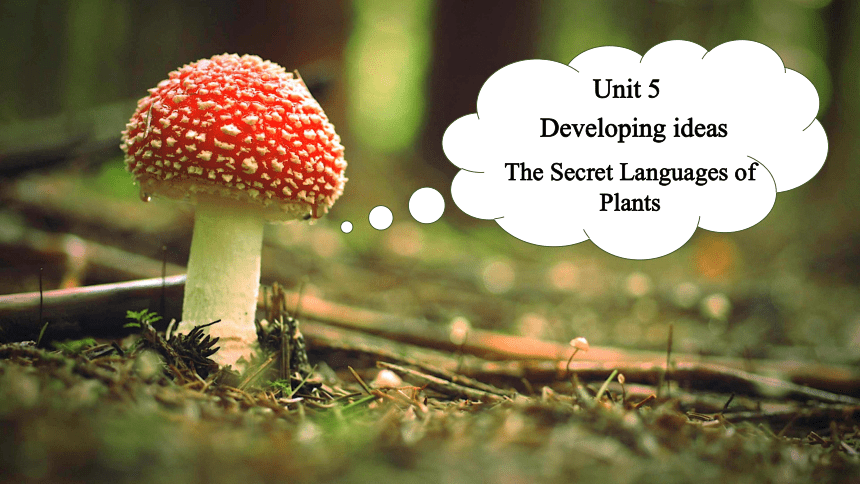
|
|
| 格式 | pptx | ||
| 文件大小 | 21.8MB | ||
| 资源类型 | 教案 | ||
| 版本资源 | 外研版(2019) | ||
| 科目 | 英语 | ||
| 更新时间 | 2025-01-05 20:24:31 | ||
图片预览

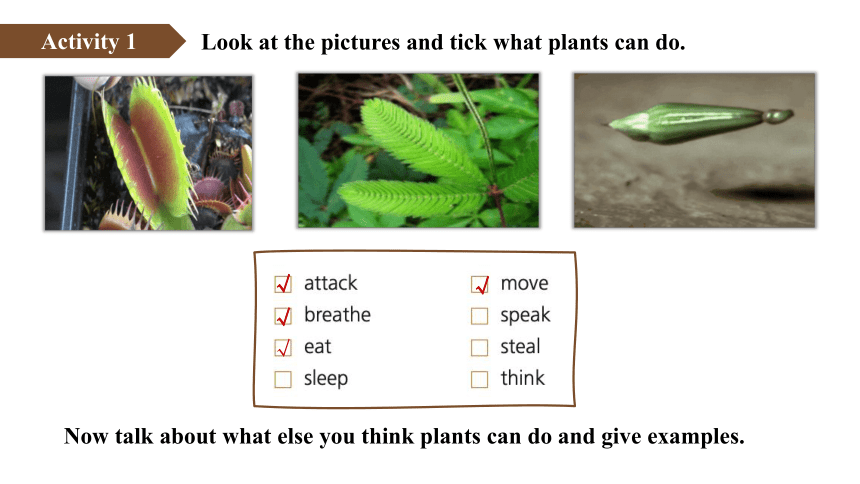
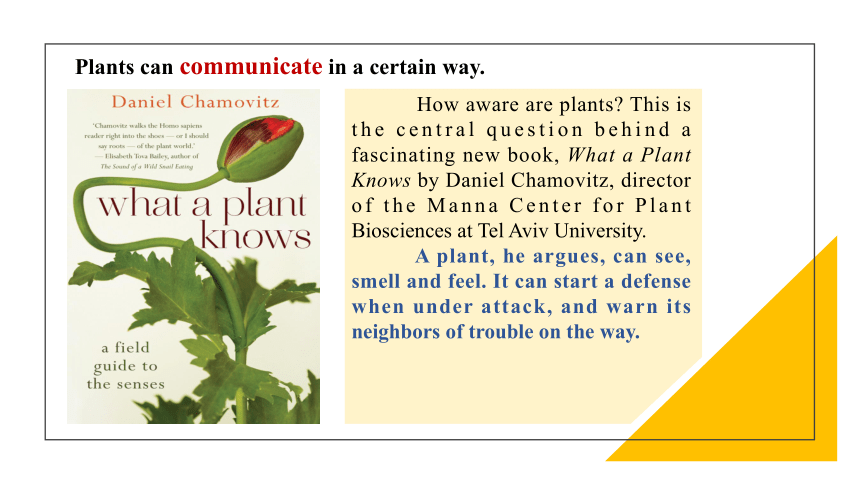
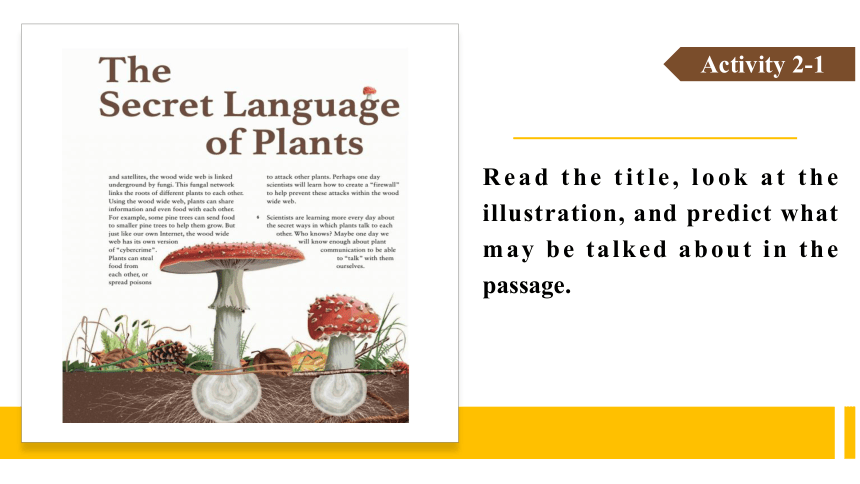
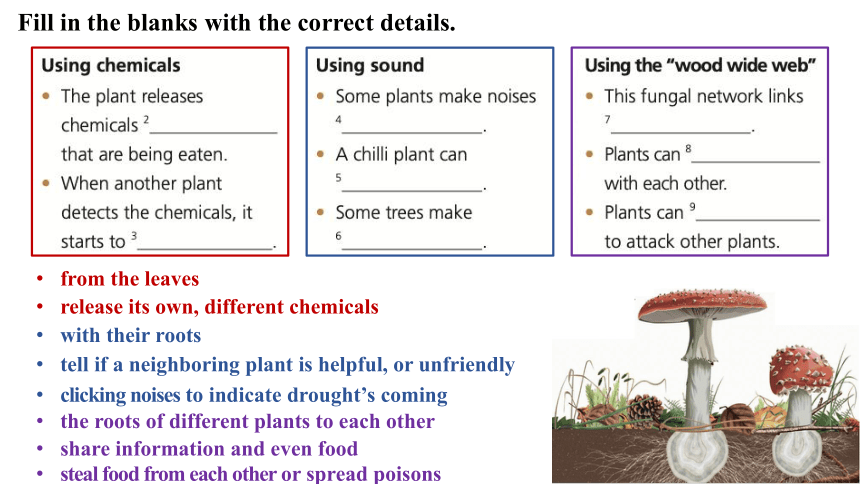
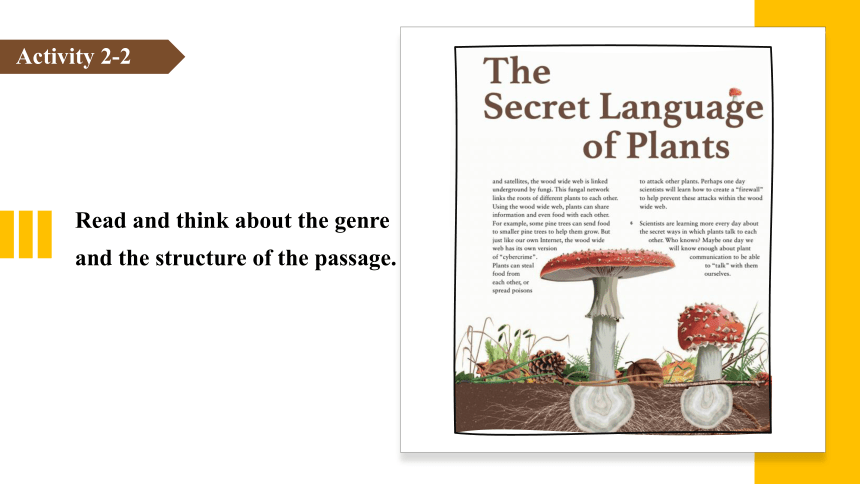

文档简介
(共16张PPT)
The Secret Languages of Plants
Developing ideas
Unit 5
Look at the pictures and tick what plants can do.
Activity 1
Now talk about what else you think plants can do and give examples.
√
√
√
√
How aware are plants This is the central question behind a fascinating new book, What a Plant Knows by Daniel Chamovitz, director of the Manna Center for Plant Biosciences at Tel Aviv University.
A plant, he argues, can see, smell and feel. It can start a defense when under attack, and warn its neighbors of trouble on the way.
Plants can communicate in a certain way.
Read the title, look at the illustration, and predict what may be talked about in the passage.
Activity 2-1
Fill in the blanks with the correct details.
from the leaves
release its own, different chemicals
with their roots
tell if a neighboring plant is helpful, or unfriendly
clicking noises to indicate drought’s coming
the roots of different plants to each other
share information and even food
steal food from each other or spread poisons
Activity 2-2
Read and think about the genre and the structure of the passage.
The genre:
Exposition
Part 1:
Introduction
(background and findings)
Part 2:
Main body
Part 3:
Conclusion
(evaluation)
Please summarize the main idea of each part.
Part 1 (paragraph 1-2)
Part 2 (paragraph 3-5)
Part 3 (paragraph 6)
New research has revealed something amazing: it appears that plants can communicate after all.
Plants have three ways to communicate, namely chemicals, sound and an amazing system called the “wood wide web”.
Scientists are learning more about the secret language of plants.
Read for detailed information.
Activity 3
.
— a thing of myths and legends
talking plants
stories of many cultures
some modern stories
give advice and warnings to people
communicate with animals and people
What has new research revealed
Plants can communicate.
How does the author connect part 2
They are a mark showing that the following part will explore the same topic as what has been mentioned, yet developing the topic to a deeper, further degree than all that has been written before.
What is the function of “More surprisingly” and “Most surprisingly of all”
How does the author explain the three ways of communication
By giving examples.
What is the function of Paragraph 6
It is a conclusion and a restatement of the passage topic.
It also raises an expectation about future research of plant communication.
Activity 4
1. What figure of speech is being used when the plants are described as calling for help
Think and share.
Personification.
3. What is its function
2. What is personification
Please look for more sentences with personification in this passage.
1. Talking plants have long been a thing of myths and legends.
2. Many cultures have stories of talking trees that give advice as well as warnings to people.
3. This is like a warning, or a call for help: “I’m being attacked!” When another bean plant detects the chemicals from its injured neighbour, it starts to release its own, different chemicals.
4. Some of these chemicals drive insects away. Others attract insects—the wasps!
5. They also “listen” to the noises from other plants. A chilli plant can tell if a neighboring plant is helpful, or unfriendly.
2. What do you think are the benefits of studying plant communication
know more about the world of plants
get a better understanding of the secret of nature
encourage us to explore more about the mysterious nature
teach us to live in harmony with mother nature
…
3. What discoveries are described in the two reading passages in this unit and what do their meanings have in common
Passage 1 reveals the discovery of evolution.
Passage 2 reveals the discovery of communication between plants.
They all reflect that there are numerous secrets in nature that remain to be explored.
The Secret Languages of Plants
Developing ideas
Unit 5
Look at the pictures and tick what plants can do.
Activity 1
Now talk about what else you think plants can do and give examples.
√
√
√
√
How aware are plants This is the central question behind a fascinating new book, What a Plant Knows by Daniel Chamovitz, director of the Manna Center for Plant Biosciences at Tel Aviv University.
A plant, he argues, can see, smell and feel. It can start a defense when under attack, and warn its neighbors of trouble on the way.
Plants can communicate in a certain way.
Read the title, look at the illustration, and predict what may be talked about in the passage.
Activity 2-1
Fill in the blanks with the correct details.
from the leaves
release its own, different chemicals
with their roots
tell if a neighboring plant is helpful, or unfriendly
clicking noises to indicate drought’s coming
the roots of different plants to each other
share information and even food
steal food from each other or spread poisons
Activity 2-2
Read and think about the genre and the structure of the passage.
The genre:
Exposition
Part 1:
Introduction
(background and findings)
Part 2:
Main body
Part 3:
Conclusion
(evaluation)
Please summarize the main idea of each part.
Part 1 (paragraph 1-2)
Part 2 (paragraph 3-5)
Part 3 (paragraph 6)
New research has revealed something amazing: it appears that plants can communicate after all.
Plants have three ways to communicate, namely chemicals, sound and an amazing system called the “wood wide web”.
Scientists are learning more about the secret language of plants.
Read for detailed information.
Activity 3
.
— a thing of myths and legends
talking plants
stories of many cultures
some modern stories
give advice and warnings to people
communicate with animals and people
What has new research revealed
Plants can communicate.
How does the author connect part 2
They are a mark showing that the following part will explore the same topic as what has been mentioned, yet developing the topic to a deeper, further degree than all that has been written before.
What is the function of “More surprisingly” and “Most surprisingly of all”
How does the author explain the three ways of communication
By giving examples.
What is the function of Paragraph 6
It is a conclusion and a restatement of the passage topic.
It also raises an expectation about future research of plant communication.
Activity 4
1. What figure of speech is being used when the plants are described as calling for help
Think and share.
Personification.
3. What is its function
2. What is personification
Please look for more sentences with personification in this passage.
1. Talking plants have long been a thing of myths and legends.
2. Many cultures have stories of talking trees that give advice as well as warnings to people.
3. This is like a warning, or a call for help: “I’m being attacked!” When another bean plant detects the chemicals from its injured neighbour, it starts to release its own, different chemicals.
4. Some of these chemicals drive insects away. Others attract insects—the wasps!
5. They also “listen” to the noises from other plants. A chilli plant can tell if a neighboring plant is helpful, or unfriendly.
2. What do you think are the benefits of studying plant communication
know more about the world of plants
get a better understanding of the secret of nature
encourage us to explore more about the mysterious nature
teach us to live in harmony with mother nature
…
3. What discoveries are described in the two reading passages in this unit and what do their meanings have in common
Passage 1 reveals the discovery of evolution.
Passage 2 reveals the discovery of communication between plants.
They all reflect that there are numerous secrets in nature that remain to be explored.
